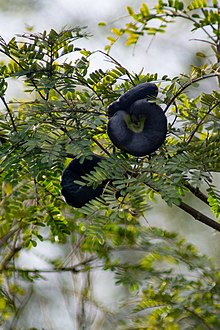| Enterolobium barinense | |
|---|---|

| |
| Enterolobium barinense, nearly ripe pod of a wild tree in Villavicencio, Colombia | |
| Scientific classification | |
| Kingdom: | Plantae |
| Clade: | Tracheophytes |
| Clade: | Angiosperms |
| Clade: | Eudicots |
| Clade: | Rosids |
| Order: | Fabales |
| Family: | Fabaceae |
| Subfamily: | Caesalpinioideae |
| Clade: | Mimosoid clade |
| Genus: | Enterolobium |
| Species: | E. barinense |
| Binomial name | |
| Enterolobium barinense L.Cárdenas & H.Rodr.-Carr. | |
Enterolobium barinense, commonly known as caro blanco or oreja de negro, is a species of flowering tree in the pea family, Fabaceae. It was previously thought to be endemic to Venezuela, but it has been located in neighboring Colombia as well. It differs from the very similar and sympatric E. cyclocarpum by its black (instead of reddish-brown) and smoother pods, and by its larger, fewer and more rounded leaflets.
References
- Barneby, Rupert C. (1996). "Silk tree, guanacaste, monkey's earring: a generic system of the synandrous Mimosaceae of the Americas. Part I. Abarema, Albizia, and allies". Memoirs of the New York Botanical Garden. 74 (1). Archived from the original on 2018-12-28. Retrieved 2018-12-28.
- Mijares, F.J.; Aymard, G.A.; Pérez-Buitrago, N. (2018). "Nuevos registros para la flora vascular de Colombia presentes en la Orinoquia y reseña histórica de las expediciones botánicas a la región". Biota Colombiana. 18 (2): 72–87. doi:10.21068/c2017.v18n02a05.
| Taxon identifiers | |
|---|---|
| Enterolobium barinense | |
This Mimosoideae-related article is a stub. You can help Misplaced Pages by expanding it. |